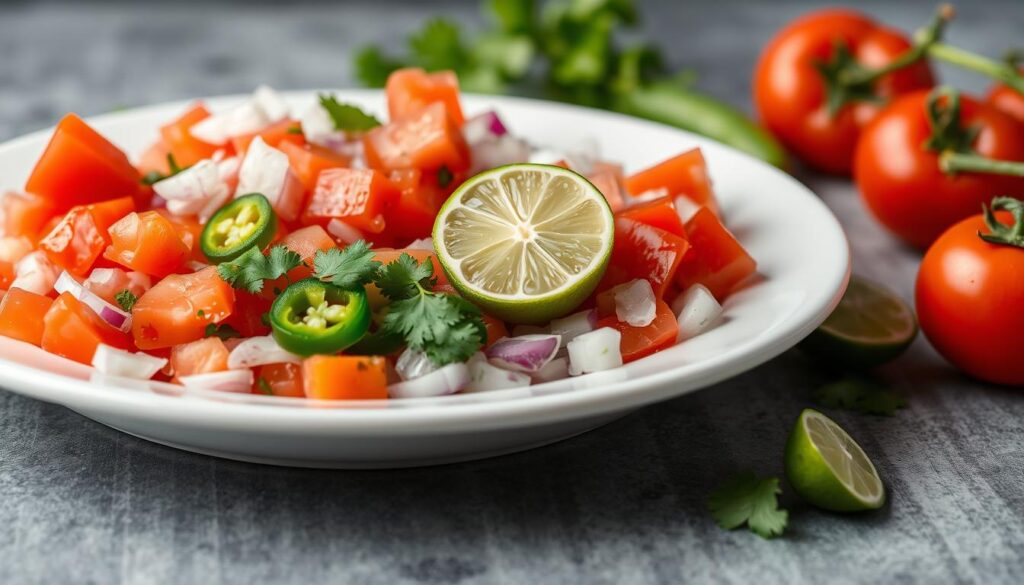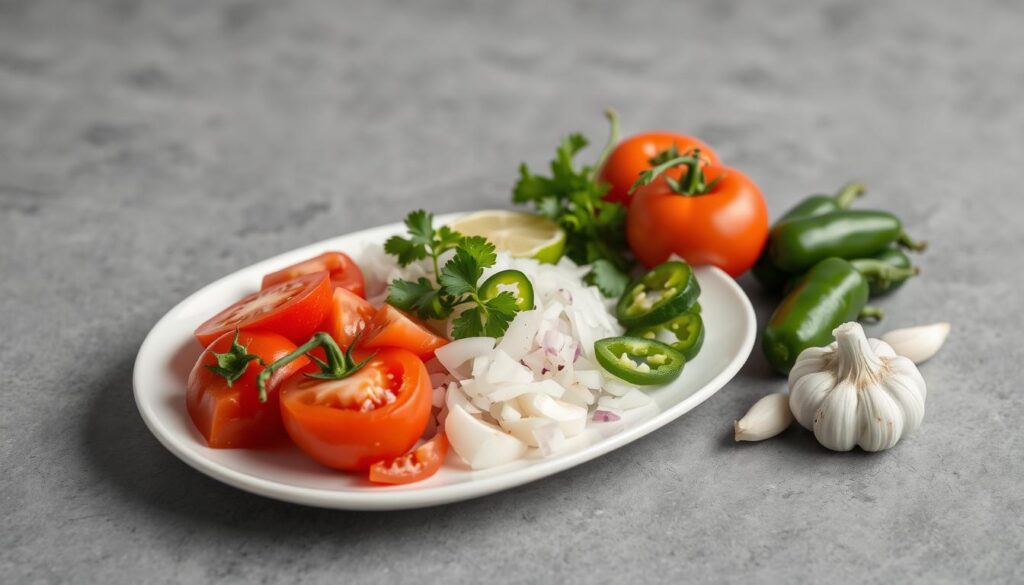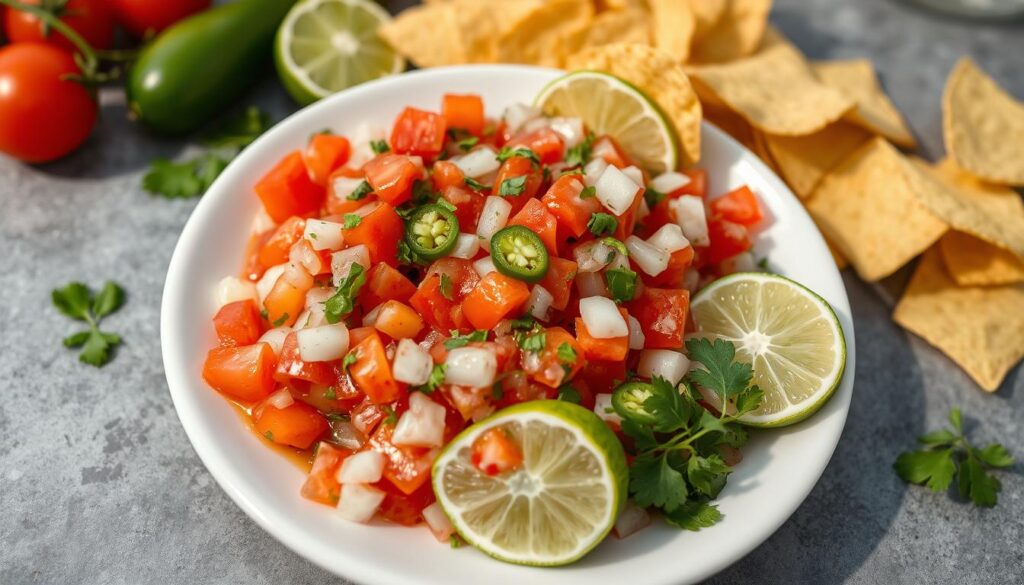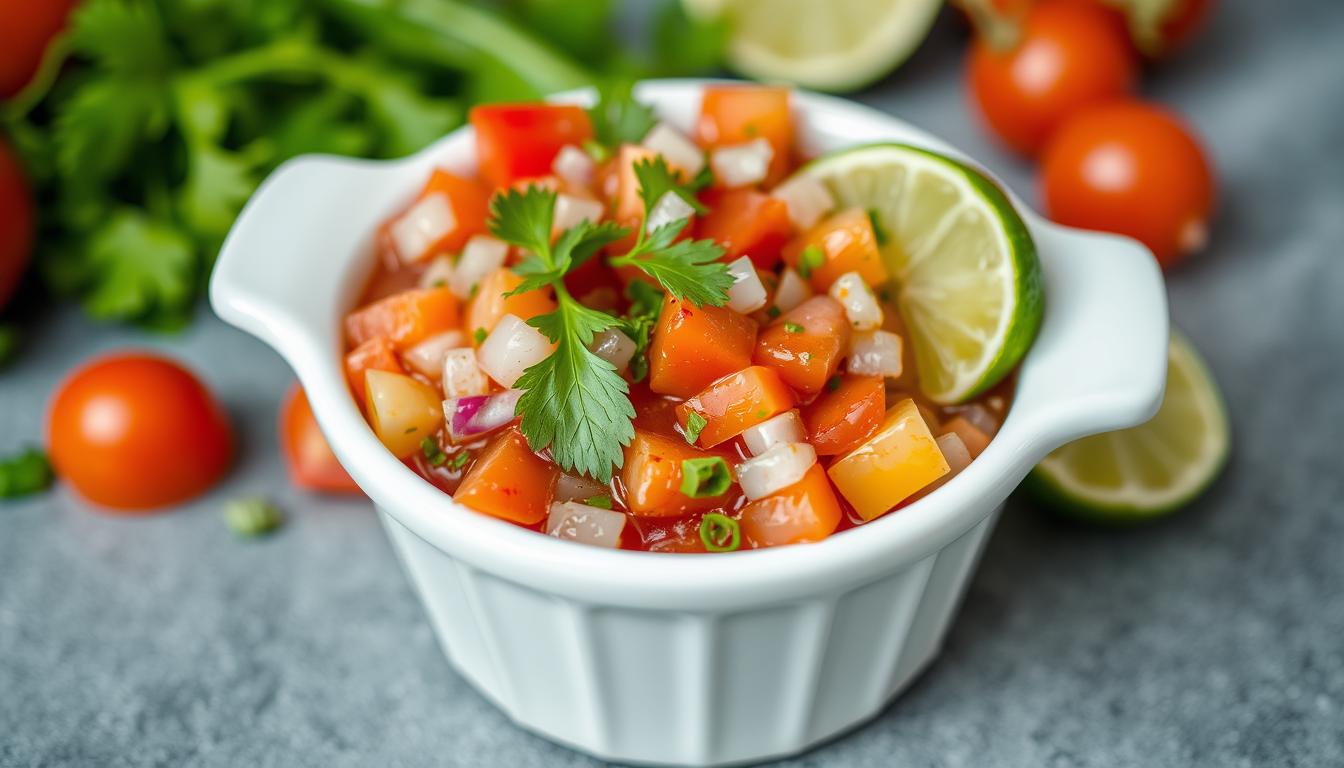Ever opened a jar of store-bought salsa and felt disappointed by its bland taste? I’ve been there, craving that vibrant, fresh flavor. Making homemade salsa is more than a recipe. It’s a way to enjoy real, zesty flavors in your kitchen.
Imagine making a fresh salsa recipe in under 15 minutes. It’s full of bright ingredients and you can choose how spicy it is. Your homemade salsa can make every meal taste like it’s from a restaurant, without the preservatives or high cost.
With just a few fresh ingredients and a little prep, you’ll make a salsa that makes every meal better. Whether you like it spicy or mild, this recipe can be adjusted to your liking. It promises a delicious experience every time.
Key Takeaways
- Homemade salsa takes under 15 minutes to prepare
- Customize spice levels to your preference
- Fresh ingredients guarantee superior taste
- Cost-effective alternative to store-bought salsa
- Versatile recipe adaptable to various dishes
Why Skip Store-Bought for Homemade Salsa
Making your own salsa at home turns a simple condiment into a work of art. Store-bought salsas often miss the fresh taste and vibrant flavors that homemade salsa offers.
Benefits of Making Fresh Salsa at Home
- Complete Ingredient Control: You choose what’s in your salsa
- Fresher taste with ingredients at their best
- No artificial preservatives
- Adjust the spice to your liking
Cost Comparison: Store-Bought vs Homemade
| Category | Store-Bought | Homemade |
|---|---|---|
| Average Cost per Serving | $1.50 | $0.50 |
| Ingredient Quality | Processed | Fresh |
| Customization | Limited | Unlimited |
Health Benefits of Fresh Ingredients
Choosing homemade salsa means more than just a tasty dip. It’s about picking whole, healthy ingredients. The USDA says homemade salsa can be safer and more nutritious than store-bought.
“Fresh ingredients are the heart of an extraordinary salsa” – Culinary Experts
Your homemade salsa lets you enjoy fresh flavors. It helps you control sodium, avoid preservatives, and boost nutrition.
Essential Ingredients for Perfect Salsa
Making the perfect homemade salsa starts with knowing the key ingredients. These ingredients make the salsa come alive. They turn simple veggies into a tasty dip.

- Fresh tomatoes (6 vine-ripened or 1 cup canned)
- Onions (about 1/4 cup, finely chopped)
- Garlic (1 clove, minced)
- Fresh jalapeño peppers (4 small, adjust for heat)
- Cilantro (1/4 to 1/2 cup)
- Lime juice (2 tablespoons)
- Ground cumin (1.5-2 teaspoons)
- Salt (1/4 teaspoon)
“The secret to an amazing salsa is balancing fresh ingredients with the right amount of spice and acidity.” – Culinary Expert
You can also add a pinch of sugar or canned green chiles for extra flavor. Choose the best, ripe produce for your salsa.
| Ingredient | Quantity | Nutritional Benefit |
|---|---|---|
| Tomatoes | 6 medium | High in Vitamin C, 67.8 mg per serving |
| Cilantro | 1/4 cup | Rich in antioxidants |
| Jalapeños | 4 small | Boosts metabolism |
| Lime Juice | 2 tablespoons | Adds brightness, aids digestion |
Pro tip: Chill your salsa in the fridge for at least an hour before serving. This lets the flavors mix, making it even tastier. Your guests will love it.
Secret Tips for Restaurant-Style Texture
Learn why Mexican restaurant salsa tastes amazing by mastering top salsa making skills. The secret is in texture, blending, and smart prep. These tips will make your homemade salsa stand out.
Professional chefs say making the perfect salsa texture is an art. Your homemade salsa can be as good as restaurant salsa with these expert tips.
Mastering Blending Techniques
The pulse function on your food processor is key for texture control. Quick pulses help you:
- Keep chunky, fresh ingredient visibility
- Avoid over-processing
- Get consistent texture
Consistency Control Methods
What makes Mexican restaurant salsa taste so good? It’s the balanced consistency. Here are some pro tips:
- Drain excess liquid from tomatoes
- Use fresh, ripe ingredients
- Adjust chopping for the right texture
Time-Saving Preparation Hacks
Make your salsa prep faster with these pro tricks:
- Deflame onions by soaking in cold water
- Prep ingredients ahead of time
- Use a food processor with at least 11-cup capacity
“The key to great salsa is balance and simplicity” – Chef Antonio Nuño
With these techniques, your homemade salsa will be a restaurant-quality hit. It will wow your family and friends.
The Role of Tomatoes in Your Salsa
Tomatoes are the main ingredient in salsa. They add a fresh, natural taste that store-bought salsas can’t match. This makes homemade salsa special.
Choosing the right tomatoes is key for a great salsa. Here are some top picks:
- Roma tomatoes: Dense and meaty, ideal for less watery salsa
- On-the-vine tomatoes: Provide excellent natural sweetness
- Heirloom varieties: Offer complex, rich flavor profiles
- Cherry or grape tomatoes: Add intense sweetness and brightness
Use fresh tomatoes instead of canned ones. They taste better, are sweeter, and have a crisp texture. This makes your salsa amazing. Here are some tips for preparing tomatoes:
- Remove seeds to reduce moisture
- Dice uniformly for consistent texture
- Let the salsa rest for 15 minutes before serving to enhance flavor integration
Pro tip: The quality of your tomatoes directly impacts the overall taste of your salsa.
Homemade salsa is tasty and healthy. It has about 23 calories per serving. Your tomato-based salsa will last 3-5 days in a sealed container. It’s great for making ahead for different meals.
Mastering the Spice Level
Making the perfect spicy salsa is an art. It’s about finding the right mix of heat, flavor, and taste. Knowing how to adjust the spice can make your homemade salsa stand out.
Mild to Hot Salsa Variations
The secret to your ideal spicy salsa is in the peppers you choose and how you prepare them. Each pepper has its own level of heat:
- Mild Salsa: Remove all pepper seeds and membranes
- Medium Salsa: Keep partial seeds for moderate heat
- Hot Spicy Salsa: Retain all seeds and membranes
Choosing the Right Peppers
The type of pepper you pick greatly affects your salsa’s heat. Here are some popular choices:
- Jalapeños: 2,500-8,000 Scoville heat units (mild to moderate)
- Habaneros: 100,000-350,000 Scoville heat units (extremely hot)
- Green bell peppers: Zero heat, perfect for mild versions
Balancing Heat and Flavor
“The secret to great spicy salsa is not just heat, but harmony of flavors.”
When making your spicy salsa, remember to balance the heat with flavor. Start with a little hot pepper and add more as needed. Roasting peppers can also soften their heat and add more flavor to your salsa.
| Pepper Type | Heat Level | Recommended Usage |
|---|---|---|
| Bell Pepper | No heat | Mild salsa base |
| Jalapeño | Mild-Medium | 1-2 peppers for balanced heat |
| Habanero | Extremely Hot | Use sparingly (1/2 pepper) |
Pro tip: Always wear gloves when handling hot peppers. Avoid touching your eyes or face during preparation. Your perfect spicy salsa is just a few careful steps away!
Step-by-Step Homemade Salsa Instructions

Making salsa at home is simple! You just need a few ingredients and basic tools. This way, you can make a fresh salsa that’s better than store-bought.
Here’s a simple way to make perfect salsa every time:
- Gather your fresh ingredients: ripe tomatoes, onions, cilantro, lime, and peppers
- Wash and chop all ingredients into small, uniform pieces
- Select your preferred blending tool: food processor or blender
- Pulse ingredients to achieve your desired consistency
Pro tip for the best flavor: Let your salsa sit for at least 30 minutes before serving. This lets the flavors mix well.
| Ingredient | Quantity |
|---|---|
| Fresh Tomatoes | 1 ¾ pounds |
| Onion | 1/3 cup chopped |
| Garlic | 2 medium cloves |
| Jalapeño Peppers | 1-2 peppers |
| Cilantro | 1 cup fresh |
| Lime | 1-2 whole limes |
“The secret to great salsa is fresh ingredients and the right balance of flavors!” – Salsa Chef
Remember, making perfect salsa takes practice. Don’t be afraid to try different seasonings and ingredient ratios. Find your perfect blend!
Fresh vs Canned Ingredients: Finding the Perfect Balance
Making the best homemade salsa means knowing how to mix fresh and canned stuff. Why is homemade salsa better? It’s all about picking the right ingredients and mixing them well.
Creating a top-notch salsa is all about choosing the right ingredients. Fresh stuff adds lively flavors. But canned items bring depth and a steady taste to your mix.
When to Use Fresh Tomatoes
Fresh tomatoes are best in summer. Roma or Plum tomatoes have a great tangy-sweet taste. Use fresh tomatoes when:
- Local produce is ripe and plenty
- You want strong flavors
- Texture matters in your salsa
Benefits of Combining Fresh and Canned
Mixing fresh and canned ingredients makes a salsa with rich flavors. Here’s why it’s good:
- It tastes the same all year
- Flavors get more complex
- It’s easy to make
“The secret to great salsa is finding the perfect balance between fresh and canned ingredients.” – Salsa Expert
Try using 1 can of diced tomatoes with green chilies and 1 can of fire-roasted diced tomatoes. This mix adds smoky notes and steady flavor.
Ingredient Ratio Recommendations
For the best taste, try this mix:
- 4 ripe fresh tomatoes
- 15 ounces crushed San Marzano canned tomatoes
- 4.5 ounces diced green chiles
- A little sugar to balance the acid
Learning to mix fresh and canned ingredients will make your homemade salsa better than store-bought.
Storage Tips and Shelf Life

Keeping your homemade salsa Fresca fresh is key. Use the right storage to keep its flavors bright. This helps it last longer without spoiling fast.
Refrigeration is key to keeping your salsa fresh. Here are some tips to keep it fresh:
- Store in an airtight container
- Keep refrigerated at 40°F or below
- Consume within 4-7 days
Knowing how long your salsa lasts is important. It keeps you safe and makes it taste better. Here are some storage tips:
| Storage Method | Duration | Best Practices |
|---|---|---|
| Refrigerated | 4-7 days | Use clean utensils, keep sealed |
| Freezer Storage | 3-4 months | Use freezer-safe containers |
Freezing your salsa is a great way to make it last longer. Pro tip: Freeze it in small portions for easy thawing.
Always trust your senses. If the salsa looks, smells, or tastes off, it’s time to discard it.
Watch for signs of spoilage. Look for mold, bad smells, or changes in texture. These mean your salsa is not safe to eat.
Creative Ways to Serve Your Salsa
Your homemade salsa is more than a dip. It’s a star that can make meals special. Whether it’s a classic tomato salsa or a mango salsa, these ideas will make your meals better.
Mexican Dish Pairings
- Top grilled chicken or fish tacos with a zesty mango salsa recipe
- Enhance enchiladas with a fresh salsa spread
- Garnish quesadillas with chunky salsa for extra flavor
- Use as a vibrant topping for burrito bowls
Unique Serving Suggestions
Your salsa can be more than a side dish. Try these creative ideas:
- Eggs: Spoon salsa over scrambled or fried eggs for a breakfast boost
- Dips: Mix salsa with cream cheese for a quick party appetizer
- Grain Bowls: Stir into quinoa or rice for instant flavor
- Protein Topper: Use as a fresh garnish for grilled meats
“Salsa isn’t just a condiment, it’s a flavor adventure!” – Chef Maria Rodriguez
Your mango salsa recipe is great with seafood and grilled dishes. It adds sweet and spicy flavors.
| Dish Type | Recommended Salsa Style | Flavor Profile |
|---|---|---|
| Grilled Fish | Mango Salsa | Sweet & Tangy |
| Chicken Tacos | Fresh Tomato Salsa | Zesty & Fresh |
| Eggs | Spicy Salsa | Bold & Awakening |
Try your mango salsa recipe with different dishes. See how it can make any meal better!
Troubleshooting Common Salsa Problems
Making the perfect homemade salsa can be tough. Even skilled cooks face issues that make their salsa not so great. Knowing how to fix common problems can help you make a tasty salsa every time.
Solving Texture and Consistency Challenges
Watery homemade salsa is a big problem for many. To fix this:
- Strain excess liquid using a fine-mesh sieve
- Remove seeds from tomatoes before chopping
- Use roma tomatoes which have less water content
Balancing Flavor Profiles
If your homemade salsa lacks depth or tastes flat, try these quick fixes:
| Issue | Solution |
|---|---|
| Too Acidic | Add 1/2 teaspoon honey or pinch of sugar |
| Bland Taste | Increase salt, add fresh lime juice |
| Too Spicy | Mix in additional green tomatoes or mild herbs |
Preserving Your Salsa
Storing your salsa right is key to keeping its quality:
- Refrigerate for up to 5 days
- Flavors typically improve after 30 minutes of resting
- Can be frozen for up to 3 months
“The secret to great homemade salsa is patience and willingness to experiment.” – Professional Chef
By learning these troubleshooting tips, you can turn salsa problems into tasty successes.
Conclusion
Making homemade salsa is more than a recipe. It’s a chance to play with flavors and connect with food history. By making your own, you get tastes that store-bought can’t match. Just 15-30 minutes of prep turns simple ingredients into a tasty sauce.
Your homemade salsa is super versatile. It’s great with chips, tacos, burritos, and grilled meats. You can change the heat and flavors to your liking. Plus, it’s healthy, low in calories, and full of vitamins.
The secret to great homemade salsa is using fresh ingredients and adding your own twist. You can make it mild or spicy, and it keeps for up to a week. This is just the start of your salsa journey.
We encourage you to share your salsa and try new things. Your kitchen is now a place for fun and flavor. Homemade salsa is your canvas to create delicious dishes.
FAQ
What are the main ingredients in a classic homemade salsa?
What is salsa mostly made of?
Why does Mexican restaurant salsa taste so good?
Why is homemade salsa better than store-bought?
How long can homemade salsa be stored?
Can I adjust the spiciness of homemade salsa?
Is it better to use fresh or canned tomatoes for salsa?
Explore More Delicious Recipes on YumeRecipes!
If you enjoyed this recipe, you’ll love these other dishes: try our comforting Artisan Vegan Jalapeno Cheddar Bread Recipe .For a cozy meal, or whip up some Halibut Fish Taco: The Best Taco Ever Made
for a quick and flavorful dinner. For dessert, indulge in our Fudgy Weed Brownies: The Ultimate Marijuana Edible or try a refreshing Immunity Shots Recipe: Revitalize Your Health . Visit YumeRecipes for even more tasty ideas!

